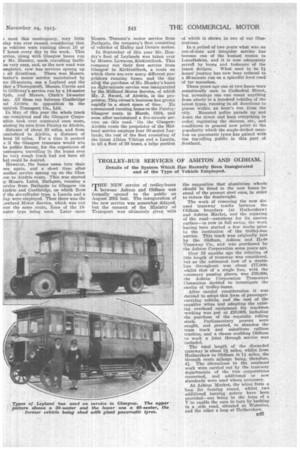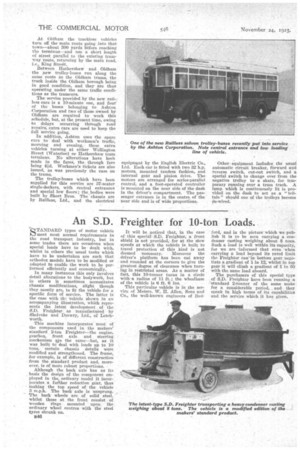TROLLEY-BUS SERVICES OF ASHTON AND OLDHAM.
Page 29

Page 30

If you've noticed an error in this article please click here to report it so we can fix it.
Details of the System Which Has Recently Been Inaugurated and of the Type of Vehicle Employed.
T"
W service of trolley-buses between Ashton and Oldham was formally opened to the public on August 26th last. The inauguration of the new service was somewhat delayed, but the consent of the Ministry of Transport was ultimately given with the suggestion that aluminium wheels should be fitted to the new buses instead of the present steel ones, in order to reduce the deadweight.
The work of removing the now die: used tramway tracks between the Oldham boundary (at Hathershaw) and Ashton Market, and the repaving of the road—notorious for its uneven surface—Ls now in full swing, the work having been started a few weeks prior to the institution of the trolley-bus service. This track was originally laid by the Oldham, Ashton and Hyde Tramway Co., and was purchased by the Ashton Corporation some years ago.
Over 18 months ago the relaying of this length of tramway was considered, but as the estimated cost of a double hue throughout was about £77,000, whilst that of a single line, with the necessary passing places, was £38,000, the Ashton Corporation Tramways Committee decided to investigate the merits of trolley-buses.
After careful consideration it was decided to adopt this form of passengercarrying vehicle, and the cost of the negative wires and adapting the existing overhead equipment for trackless working was put at £26,000, including the purchase of the requisite rolling stock. Parliamentary powers were sought, and granted, to abandon the tram track and substitute railless traction, and a clause enabling Oldham to work a joint through service was included.
The total length of the discarded tramway is about 21 miles, whilst from Hathershaw to Oldham is 11 miles, the through route mileage being, therefore, 41. The alterations to the overhead work were carried out by the tramway departments of the two corporations concerned, and additional or new standards were used where necessary.
At Ashton Market, the wires form a loop for fuming round, whilst two additional turning points have been provided—one being in the form of a V to enable the cars to turn by backing in a side road, situated at Waterloo, and the other a loop at Hathershaw. At Oldham the trackless vehicles turn off the main route going into that town—about 300 yards before reaching the terminus—and use a short length of street parallel to the existing tramway route, returning by the main road, i.e., King Stregt.
Between Hathershaw and Oldham the new trolley-buses run along the same route as the Oldham trams, the track inside the Oldham borough being in good condition, and they are thus operating under the same traffic conditions as the tramcars.
The service provided by the new railless cars is a 10-minute one, and four of the buses belonging to Ashton • Corporation and two of those owned by Oldham are required to work this schedule, but, at the present time' owing to delays occurring through road repairs, extra cars are used to keep the full service going.
In addition, Ashton uses the spare cars to deal with workmen's traffic, morning and evening, these extra vehicles turning at either Wellington Street (Waterloo) or Hathershaw tram terminus. No alterations have been made in the fares, the through fare being 41d. Workmen's tickets are also issued, as was previously the case on the trams.
The trolley-buses which have been supplied for this service are 37-seater single-deckers, with central entrances and special low floors ; the bodies were built by Short Bros. The chassis are by Railless, Ltd., and the electrical equipment by the English Electric Co., Ltd. Each car is fitted with two 32 lap. motors, mounted tandem fashion, and internal gear and pinion drive. The motors are arranged for series-parallel control, and a foot-operated controller is mounted on the near side of the dash in the driver's compartment. The passenger entrance is in the centre of the near side and is of wide proportions. Other equipment includes the usual automatic circuit breaker, forward and reverse switch, cut-out switch, and a special switch to change over from the negative trolley to a skate, for temporary running over a train track. A lamp which is continuously lit is provided on the dash to act as a " telltale" should one of the trolleys become de-wired.




































